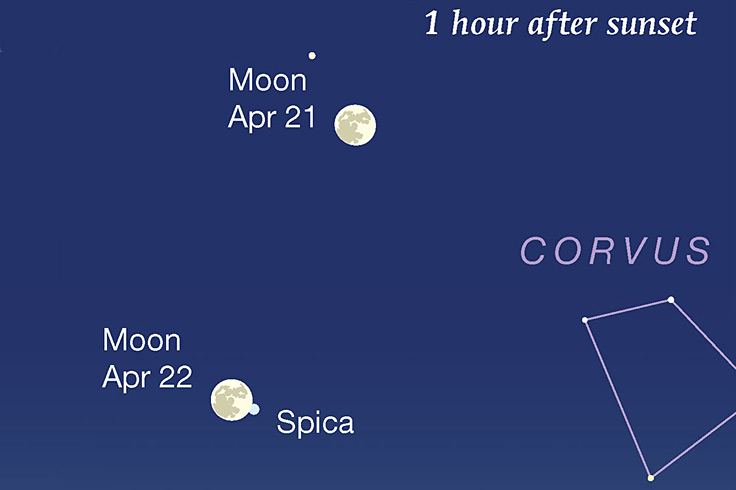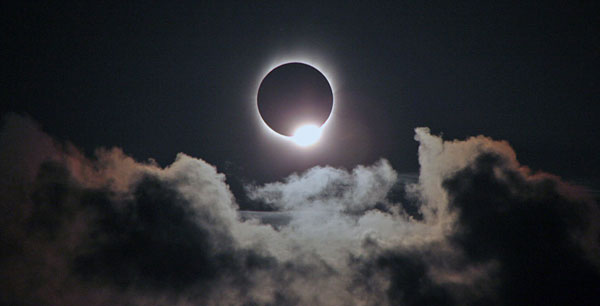
This Week's Sky at a Glance, April 26 – May 5
All the planets now huddle around our line of sight toward the Sun. However, these moonless evenings present us the Spring Triangle, the Great Diamond with a sugar sprinkle on its edge, and the Pointers aligned vertically.

This Week's Sky at a Glance, April 19 – 28
Springtime Leo walks high in the south, springtime Hydra snakes a quarter of the way around the celestial sphere, and the bright Moon aligns with Spica.

Explore the Night with Bob King
Jupiter Meets Uranus in Twilight; Supernova Erupts in Nearby Spiral Galaxy
Jupiter aligns with distant Uranus before it exits the evening sky as a bright supernova flares in the southern galaxy NGC 3621.

This Week's Sky at a Glance, April 12 – 21
Jupiter is easy to spot, shining low in the west at nightfall. Near it are Uranus and Comet Pons-Brooks, tougher catches that require binoculars or a wide-field telescope — and some finding skills.

The Totality Experience: S&T’s Eclipse Stories
With Sky & Telescope’s editors and writers scattered across the eclipse path, we have dozens of stories to share. Here are a few.

11 Things to Take With You the Day of the Solar Eclipse
You might have your eclipse-viewing plans all worked out, but have you thought about all the other things you might need?

This Week's Sky at a Glance, April 5 – 14
Venus and Jupiter may shine through the blue sky during the April 8th solar eclipse even if the eclipse for you is only deep partial. After dark, Orion walks down in the southwest.

Where to Watch the Total Solar Eclipse Online
Watch the total solar eclipse — alongside interviews with scientists and astronauts — with these livestreams.

This Week's Sky at a Glance, March 29 – April 7
What? You say you're bored? The evening sky is moonless, the two Dog Stars align vertically, the Big Dipper dumps into the Little Dipper, and the Springs of the Gazelle cross the zenith.

Apps to Help You See the Solar Eclipse
For the April 8th eclipse, mobile apps offer everything from weather forecasts to local circumstances. Here's a review of eclipse apps that you might find useful on the big day.

Explore the Night with Bob King
What Will We See in the Sky During Totality?
Most of our time will be focused on Sun during the minutes of totality on April 8th, but consider tearing yourself away for a few seconds to put it all in context.
Partial: The Solar Eclipse for the Rest of Us
Whether the Sun will become a dented ball or an eerie crescent of fire, a celestial shadow show awaits you practically everywhere in North and Central America.

This Week's Sky at a Glance, March 22 – 31
The full Moon will go through a penumbral eclipse. Comet Pons-Brooks nears its best showing in early evening. And as Mercury fades in the sunset, Jupiter becomes the only easy planet in the entire sky.

This Week's Sky at a Glance, March 15 – 24
Mercury emerges in the sunset, far lower right of brighter Jupiter. And don't just arc to Arcturus and speed to Spica — continue the curve to Corvus, cruise to Capella, and more.

Explore the Night with Bob King
Is Betelgeuse Fading Again?
Betelgeuse has dipped nearly half a magnitude since late January. Could it be headed for another Great Dimming Event? We also take a look at this spring's "other" eclipse.

This Week's Sky at a Glance, March 8 – 17
The Moon sidles up to bold Jupiter, then the delicate Pleiades, then the Castor and Pollux twins. Arcturus, ascending in the east, is probably the third-brightest star you've ever seen and that's including the Sun.

This Week's Sky at a Glance, March 1 – 9
It's early March, so the Winter Triangle balances on Sirius after dark. The Gemini twins float high across the meridian. Leo jumps the gun on spring.

This Week's Sky at a Glance, February 23 – March 3
The full Moon splits the Sickle, the dawn Moon occults Antares, carnivore constellations stand up in the east, and the zodiacal light is at its evening best.

This Week's Sky at a Glance, February 16 – 25
The Moon waxes from first quarter to full this week, traveling from the Pleiades past the not-quite-twin heads of Gemini to the Sickle of Leo. The Big Dipper and Cassiopeia stand in balance. Venus meets Mars low in the dawn.

This Week's Sky at a Glance, February 9 – 17
The first-quarter Moon passes the Pleiades, then Aldebaran. Cassiopeia stands on end. For the southern U.S., Canopus culminates far under Sirius.
